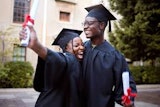WASHINGTON, D.C. – If program leaders want their STEM proposals to stand out at the National Science Foundation, think global and think collaboratively, two NSF officials said Friday at a conference on producing more globally-minded STEM students.
“If your research proposal has an international dimension to it, you’re going to score higher,” said Susan C. Kemnitzer, deputy director of the Division of Engineering Education and Centers of the National Science Foundation, or NSF.
Kemnitzer offered that insight on the final day of “Creating Globally Minded STEM Professionals Through Internships/Work Abroad Programs,” hosted by the Institute of International Education (IIE). Her remarks were made during a panel discussion on funding models for work abroad programs.
Kemnitzer said institutions searching for funds for engineering projects should review criteria under “PD 10-1340” on the NSF website. Among other things, she said, her division will entertain proposals to do research on how the international experience changes students.
“We also are looking for ways to take existing research activities that are going on in the U.S. and link them with similar research in other countries,” Kemnitzer said.
However, working with institutions in other countries has to involve a substantive, two-way partnership, said Nancy Sung, Program Director for the East-Asia Pacific, Office of International Science and Engineering at NSF.
“We want to see true intellectual collaboration that’s not one-sided,” Sung said.
“We want to see both sides engaged in raising the research questions. We want to see mutual benefits for the U.S. and the foreign partners.”
Other speakers gave attendees a glimpse at a variety of ways to finance work abroad experiences.
Dr. Larry Shuman, chair-elect of Global Engineering Education Exchange, or Global E3, a program within IIE, said Global E3 represents a more advantageous alternative to universities trying to form individual bilateral exchange agreements on their own with various foreign institutions.
“The real advantage of this is you don’t have to do all the work that you normally do if you were managing a series of bilaterals,” said Shuman, professor and associate dean for academic affairs in the Swanson School of Engineering at the University of Pittsburgh.
“At my university, we’ve gone from a number of bilaterals, none of which were really productive, to basically this one opportunity,” Shuman said.
Students who may want to go to countries that range from Singapore to Australia can do so because universities in those countries belong to Global E3.
“We don’t need to create other opportunities,” Shuman said.
Members of Global E3 must teach in English, so foreign language instruction is one less thing American institutions have to provide.
“We think this is a really great way of getting your students out in the world,” Shuman said.
Belonging to the network of Global E3 also increases visibility, he said.
“It’s nice to say, ‘We’re part of a consortium that includes Illinois and Georgia Tech and Wisconsin,” Shuman said.
Maj Fischer, director of the International Internship Program at the University of Wisconsin, spoke of how her office developed an online course where students can get credit for their work abroad experience – something that had previously been problematic.
Students pay a program fee that is consistent with the tuition schedule at UW, and the revenue is used to fund the program staff salaries and to provide scholarships and insurance to students as they work abroad.
“The idea is to get traction with students, so they hear about it, know the course exists,” Fischer said of the course, which requires students to do field journal postings and responses, read and discuss various materials, write a final paper and put together a professional portfolio project.
“It’s a way for them to get credit for the international internship,” Fischer said of the course, which is expected to have 40 students this summer, eight of whom Fischer plans to lead to India for a project that involves aquaponics – a combination of hydroponics and aquaculture.
Sabeen Altaf, Manager of STEM Programs at IIE, encouraged attendees to explore IIE’s Whitaker International Program.
IIE inherited the program from the Whitaker Foundation, which ceased operations in 2006.
“They wanted us to build a program similar to the Fulbright, but especially for biomedical engineers,” Altaf said. “The goal is not just great scientists and leaders and professionals, but growing the field of biomedical engineering with an international perspective.”
Among other things, the program offers generous grants, airfare and tuition reimbursement of up to $35,000 to students at all levels of post-secondary education to study anywhere outside of the U.S. and Canada.
IIE has made more than 200 Whitaker grants within the past six years. The proposal success rate is about 40 percent. In 2013-14 IIE expects to make 100 Whitaker grants. Projects in the past have ranged from the more conventional – such as heart fluid dynamics research – to less-explored areas. Of the lesser-explored areas, Altaf recounted how one student did a policy project that focused on biomedical engineering research in Taiwan.
” It was fascinating work,” Altaf said.


















